

Travelogue
Buen Camino
by Norman Bituin
"Buen camino" in Spanish literally means good road. But it can also mean good path, path being physically or spiritually. It is the greeting shared by pilgrims, hikers, and bicyclers and also with local people who wish you well on the Camino de Santiago in the Galicia region of Spain. I had the chance to say "Buen camino" to other hikers when I walked the last 20 kms. only of the 780-km. Camino Frances. But I am getting ahead of myself. More on that later.
I had been to Portugal once and Spain twice. The first time was in July 2004 when our family of five drove in a Peugeot rental car through Belgium, Luxembourg, France, Spain and Portugal. (This was before the Travelogue section in our website which we started in 2009). The second time was in Barcelona and southern Spain (Malaga, Marbella, Sevilla, Cordoba, Granada and Gibraltar-UK) in October 2011, in Travelogue as "Pasyal sa España". But I still wanted to visit the pilgrimage town of Santiago de Compostela and the Basque region in northern Spain. Another item in my bucket list was to see a bullfight in the Plaza de Toros in Madrid.
I planned my solo trip of 20 days from April 28-May 17, 2019 before the start of the tourist and summer season. I had purchased all my plane, train, bus and bullfight tickets and had booked my budget hotel lodgings 2-3 months ahead. I would fly in and start at Lisbon; then go north with stops at Coimbra and Porto in Portugal. In Spain, I would continue to Santiago de Compostela; then the Basque region using Bilbao as my base to the towns of Guernica, Donostia-San Sebastian, Pamplona and Bayonne (France). The last leg would be to Madrid, my base for Segovia and Valencia. I timed my trip to end in Madrid at the capital's annual celebration and 4th centennial on May 15 in honor of its patron saint, San Isidro Labrador, at the grand Fiestas de San Isidro.
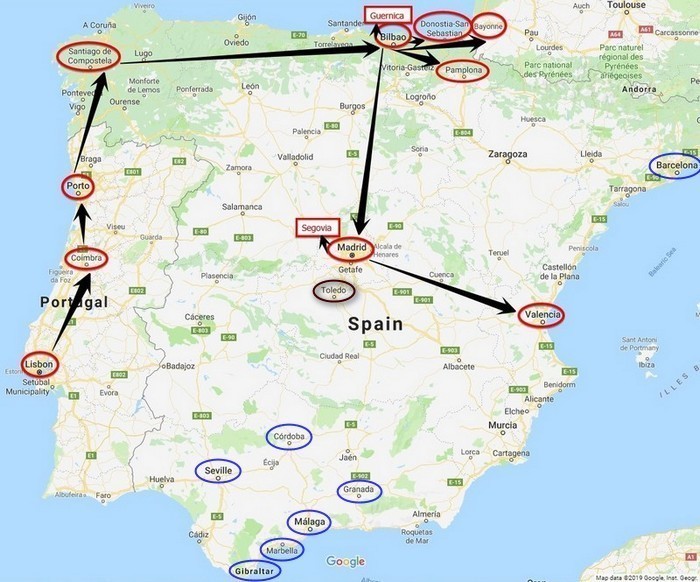
I had my backpack with only 6 change of clothes (which meant I was going to do a bit of laundering) and my camera bag. The plane ticket deal I got was for no check-in luggage, only a handcarry, which was all I needed. As usual in my travel journals, I will only include a short history or background on the city for information and put captions on the pictures as needed.
A. Lisbon
Lisbon is the capital and the largest city of Portugal. It is one of the oldest cities in the world and predates London, Paris and Rome by centuries. Julius Caesar made it a municipium and was ruled by a series of Germanic tribes from the 5th century. It was captured by the Moors in the 8th century. In 1147, the Crusaders under Afonso Henriques reconquered the city.
We spent a few days here in Lisbon and Fatima in 2004 and had seen most of the top sites. This was a go-easy relaxing couple of days for me after the flight from the US.
Rossio Square is the liveliest square in the city with the National Theatre, a baroque monument and fountain. It is surrounded by shops, outdoor cafes and restaurants.
My room on the top floor of the budget hotel, Pensao Estacao Central, looks down on the pedestrian street below across from Rossio Square.
From Praca da Figueira, the historic yellow "Remodelado" tram rattles and screeches through the narrow streets of Lisbon.
Tram Line 25 I am riding in is going up the hill to Castelo San Jorge.
Rooftop view from the Castelo
Praca do Comercio
Seafood is Lisbon's specialty. I had the popular salted codfish, bacalhau, for lunch and grilled octopus in olive oil for dinner.
For "comfort" dessert, I recommend pastel de nata for 1 euro or 6 for 5.50.
Strolling at Rossio Square at night with a bag of pastel de nata.
Monument to the Discoveries (Padrão dos Descobrimentos), near the 16th century fortification Torre de Belem, honors the Portuguese navigators.
One of those famed Portuguse navigators, of course, is Ferdinand Magellan. I ate at this McDonald's located at a street in Coimbra named after him.
View of Jeronimos Monastery and the Tagus River from the Monument to the Discoveries watchtower
Jeronimos Monastery
The construction of the monastery and church funded by King Manuel I began on January 6, 1501 and was completed 100 years later.
Jeronimos Monastery was declared a UNESCO World Heritage Site in 1983.
King Manuel I asked the pope's permission to build a monastery to honor the Virgin Mary for the successful voyage of Vasco de Gama to India, who is buried here.
B. Coimbra
Coimbra was the capital of Portugal from 1131 to 1255. It is the fourth-largest urban center in Portugal after Lisbon, Porto and Braga. Coimbra began to evolve into a major cultural center due to the establishment of the University of Coimbra in 1290, the oldest academic institution in the Portuguese-speaking world. It has about 20,000 students from 70 different nationalities with almost 10% of its students foreigners. The city of Coimbra has a total of 35,000 higher education students.
University of Coimbra
Founded in 1290, student population is about 20,000 from 70 different nationalities.
New graduates toss their togas.
The ladies horseplay and have fun too.
Coimbra City Center
C. Porto
The town that gave the country and port wine its very name, Porto, is Portugal’s second-largest metropolis after Lisbon. The old town, centered at Ribeira ("riverside"), was built on the hills overlooking the Douro River, and today is a UNESCO World Heritage Site. The region is famed for the production of Port, which is still stored and matured in the vast cellars that stretch along the banks of the Douro River.
São Bento Railway Station
São Bento is the main terminus of Porto's suburban railways lines that was inaugurated in 1916.
A Porto attraction, the French Beaux-Arts structure has about 20,000 azulejo tin-glazed ceramic tiles depicting Portugal’s past - its royalty, wars and history.
Included in the landscapes and ethnographic displays are the Battle of Valdevez (1140) and the Conquest of Ceuta (1415).
Praca da Liberdade is a favorite meeting spot for tour groups and visitors.
The Clerigos Church was built between 1735 and 1748 in a baroque style.
It is topped by the Clerigos Tower, the tallest campanile in Portugal, that stands 249 ft.
Carmo and Carmelitas Churches were built side by side in 1768 dedicated to Saint Anne, mother of Mary.
Carmo Church is decorated on the outside with a panel of azulejos depicting the taking of the veil by the Carmelites.
Porto Cathedral was completed in 1737.
Ponte de Dom Luis I / Dom Luis I Bridge
At its construction (1881-1886), the double-deck arch Ponte de Dom Luis I with a span of 172 meters was the longest bridge of its type in the world.
I'm standing on the upper deck of the Dom Luis I Bridge over the Douro River.
The grassy knoll (pic above) along the Douro River near the lower deck of the Dom Luis I Bridge is a favorite spot to watch the sunset, as I did.
Ribeira
The waterfront (Cais da Ribeira) is a long strip of cafes, restos and shops overlooking the Douro River and the Port houses of Vila Nova de Gaia on the opposite bank.
Calem Port House
Port wine is a fortified wine produced with distilled grape spirits exclusively in the Douro Valley. It is usually 19-20% alcohol.
The Calem cellars offer the tawny, ruby and white at their wine tasting tour.
D. Santiago de Compostela
Santiago de Compostela is the capital of the autonomous community of Galicia in northwestern Spain. In 1985, the city's Old Town was designated a UNESCO World Heritage Site.
According to Catholic tradition, Apostle James, son of Zebedee, spread Christianity in Spain. In the year 44 AD, he was beheaded in Jerusalem by King Herod. His remains were later transferred to Galicia in a stone boat, to the place where stands Santiago de Compostela Cathedral. The 1,000-year-old pilgrimage to the shrine of St. James in the Cathedral of Santiago de Compostela is known in Spanish as the Camino de Santiago or the Way of St. James in English. Over 200,000 pilgrims travel to the city each year from points all over Europe and other parts of the world. Saint James is the patron saint of Spain.
Camino de Santiago
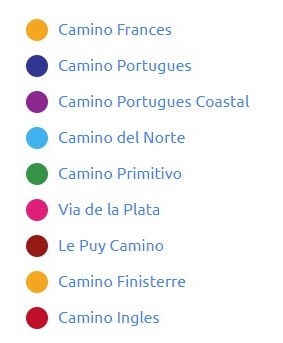
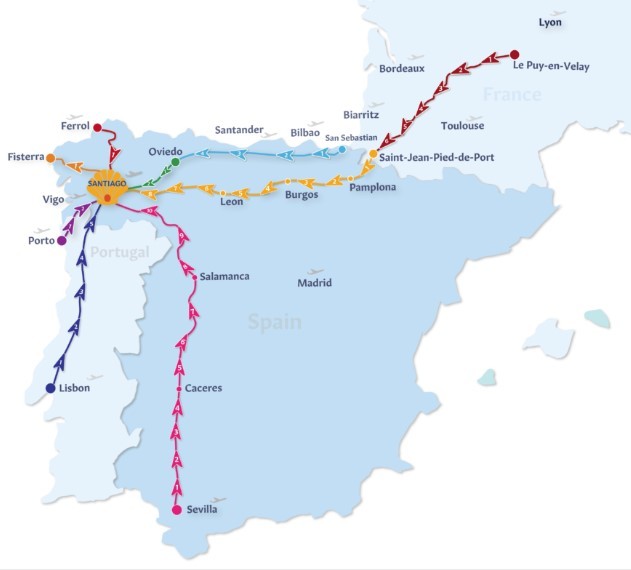
There are several established Camino routes that start in different cities and end in Santiago de Compostela. The most popular route with 60% of pilgrims choosing this way is the Camino Frances that starts at the French town of Saint-Jean-Pied-de-Port near the border with Spain for a distance of 780 kms. The second popular route is the Camino Portugues that starts in Lisbon for a distance of 616 kms.
In my "super mini" pilgrimage, I decided to walk from the town of O Pedrouzo, 20 kms. away on the Camino Frances, just to get a feel of the physical and/or spiritual experience. If I were 20-30 years younger, I'd go for the full Camino!
Starting at the town of O Pedrouzo, 20 kms. to Santiago de Compostela
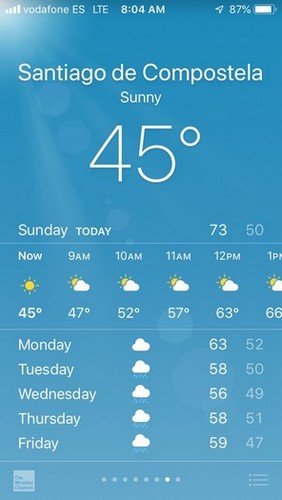
A nippy 45F (7C) to start the day, I wore my yellow shirt to match the Camino's color.
Scenes along the Camino
Yellow arrows and markers along the way guide the pilgrims.
A welcome wayside B&B and snack area
The scallop shell, indigenous to the Galician coast, worn or tied at the backpacks is the most iconic symbol of the Camino since 1106.
Monte de Gozo (Hill of Joy) at 1,210 feet overlooks the city of Santiago, about 3 kms. away.
Pope John Paul II visited the hill to lead the final mass in August 1989 of that year's World Youth Day.
Reaching the Cathedral
Peregrinos (pilgrims) sprawl out at the Plaza de Obraidoro in front of the Cathedral in relief and jubilation.
Construction of the Catedral de Santiago began in 1075 and the Basilica was consecrated in 1211.
Currently, internal restorations are being done in the Catedral with final completion expected by 2020.
The sepulcrum of Saint James in the Cathedral is open to the public, no photography allowed.
Breakfast: hot chocolate and churros. Dinner: jamon iberico ($$$), padron peppers, cheese & bread, and Galician beer.
View of the Catedral from Parque de Alameda
E. Bilbao
Bilbao, founded in the early 14th century, is the de facto capital of the autonomous Basque Country. The term Basque Country refers to a collection of regions that straddle the westernmost Pyrenees in adjacent parts of northern Spain and southwestern France that is inhabited by the Basque people. The standardised form of the Basque language, called Euskara, was developed from all the dialects in the region.
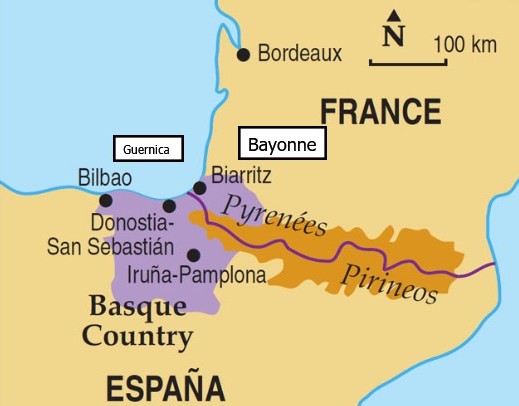
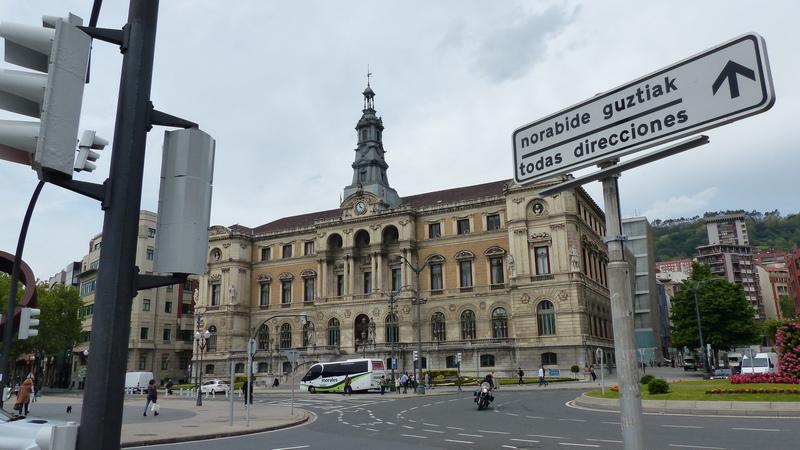
In Basque Country, as on the street sign, the Basque language comes first, then Spanish.
Ria de Bilbao
Guggenheim Museum
The Guggenheim Museum is a museum of modern and contemporary art designed by Canadian-American architect Frank Gehry.
The museum was inaugurated on October 18, 1997 by King Juan Carlos I of Spain.
Mercado de la Ribera
Mercado de la Ribera is recognized as the most complete municipal food market by the Guinness Book of Records.
The food restos and stalls offer a wide selection of pintxos in Basque (or tapas in Spanish), as I had here.
Casco Viejo (Old Town)
Funicular de Artxanda
Opened in 1915, from the lookout platform at about 250 meters the funicular offers panoramic views of the city.
Checking out at Bilbao's Hotel La Estrella (Estrella, my last name in Spanish) to board the train at Estacion Abando.
F. Guernica
Guernica, official and Basque name Gernika, is a town in the province of Biscay and was founded in 1366. According to official Basque figures, 1,654 civilians were killed when it was bombed by the Nazi Germans and Fascist Italians in 1937.
Gernika Peace Museum
Picasso's famous painting "Guernica" is a reminder of the tragedies of war, an anti-war symbol, and an embodiment of peace.
The original canvas standing at 3.49 meters (11 ft. 5 in.) tall and 7.76 meters (25 ft. 6 in.) wide is in Reina Sofia Museum in Madrid.
The bombing of Guernica on April 26, 1937 was an aerial bombing of this Basque town during the Spanish Civil War, at the behest of Spanish dictator Francisco Franco,
by the Nazi German Luftwaffe and the Fascist Italian Aviazione Legionaria. The operation opened the way to Franco's capture of Bilbao and his victory in northern Spain.
As John Lennon left us in his song -- "Give peace a chance".
G. Donostia-San Sebastian
Donostia-San Sebastián is a resort town on the Bay of Biscay known for its beautiful beaches Playa de la Concha and Playa de Ondarreta. It was founded in 1180.
The famous beach of La Concha
El Buen Pastor Cathedral
El Buen Pastor Cathedral, one of the icons of the city, was built by architect Manuel de Echave who finished construction works in 1897.
The organ is one one of the largest ever made in Europe and the largest in Spain. The organ has
5 manual keyboards and 1 pedal board. It also has 9,535 pipes, one of which is 10 meters high.
Basilica of Saint Mary of Coro
The Basilica of Saint Mary of Coro is a baroque Roman Catholic parish church and minor basilica completed in 1774.
H. Pamplona
Pamplona is the capital of Navarre province in northern Spain. It is best known for the Running of the Bulls at the Feast of San Fermín in July. It was founded in 75 BC by Gnaeus Pompeius Magnus as a military settlement.
The bus is a convenient and cheap way of touring the towns in Basque Country. For multiple travelers together, car rental is also affordable and maybe a better option.
.
Streets of Pamplona
This is the starting point of the Running of the Bulls on Pamplona streets at the Saint of Fermin Festival every July.
The inscription on the plate at the middle post reads, in English - "To those who have died the running of the bulls."
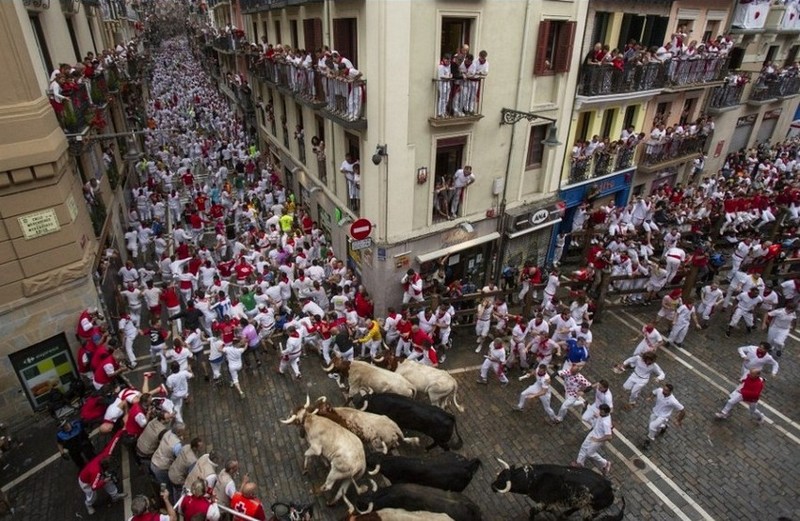
Running of the Bulls
[This is an online photo]
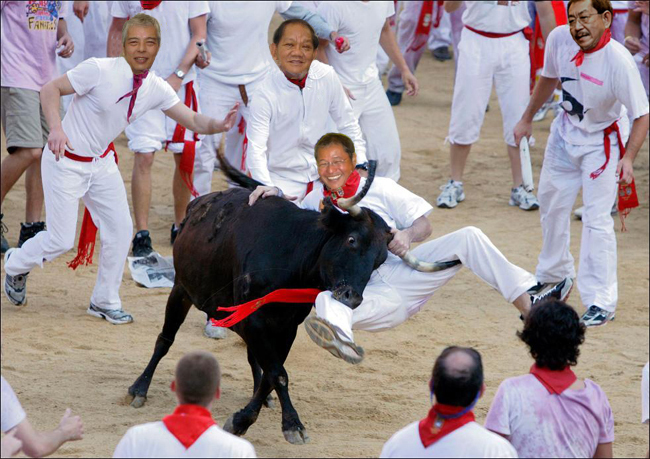
An amateurish photoshop I inserted at "Pasyal sa España" (Part 3).
I. Bayonne
Bayonne (Basque: Baiona; Spanish: Bayona) is a Basque city in southwestern France. In 1451 the city was taken from the English by the Crown of France after the Hundred Years' War. Bayonne has a reputation for good chocolates.
Sainte-Marie Cathedral
The Sainte-Marie Cathedral was first begun in 1213. It was destroyed by fire in 1224 and by lightning in 1310. It was rebuilt in 1451.
J. Madrid
Madrid is the capital and most populous city of Spain. The city has almost 3.3 million inhabitants and a metropolitan area population of approximately 6.5 million.
Rizal Monument at Avenida de Filipinas off Islas Filipinas subway stop
In Madrid's subway system, one of the the Metro stops is Islas Filipinas.
The Rizal Monument is at the corner of Avenida de Filipinas and Calle Santander, a few minutes walk from the subway.
(There is also Calle de Jose Rizal, but it is in another area in Madrid).
Dr. Jose Rizal's monument in Madrid, a replica of the Luneta monument in Manila, built in 1996 is the venue of commemorations associated with the national hero.
Runners and walkers fill the streets of Madrid on Women's Walkathon, May 12, 2019
Plaza de Toros de Las Ventas
The home of bullfighting in Spain and arguably in the world was inaugurated in 1931 and replaced an old arena built in 1874.
Bullfighting is an art and also a ritual. After reading Ernest Hemingway's "The Sun Also Rises" years back, you'd almost want to or have to see one. To understand and better appreciate what I was going to watch, I read up first on the bullfight (corrida). Below is a summary. Also as a fair warning, some of the pictures might be graphic but I could only capture the unfolding event with my camera.
o The corrida (bullfight) is divided in three tercios (stages) and two suertes (parts). The first tercio is called varas (Pikes); the second tercio, banderillas (Little Harpoons); and the third tercio, muerte (Death). The first suerte is capote, when the bullfighter uses the capote (cape); and the second suerte is muleta, when the bullfighter uses the muleta (a scarlet cloth folded over a wooden stick). On the third tercio, the matador will switch from the suerte de capote to the suerte de muleta.
o The duration of a normal corrida ranges from one hour and a half to two hours and a half. The average length of a faena (work with one bull) is around 20 minutes.
o La cuadrilla is the team of the matador. In a normal corrida (those in which six bulls are killed by three matadors) every matador is assisted by two picadors and three secondary bullfighters (subalternos).
o The picador drives the pike into the loin of the bull when the animal is attacking the breast of the horse. After that he makes the horse turn so that the bull will impact the rib area of the horse while he is harming the goring animal with the pike.
o The subalterno uses the harpoons (banderillos) to "revive" the bull, who normally tends to slow down after the tercio de varas. When the harpoons are driven into his loin, the courage and brave character of the bull will anger him and force him to gore again when he is provoked.
o The matador uses the muleta (a scarlet cloth folded over a wooden stick) and the estoque (sword) in the tercio de muerte. He is in charge of conducting the lidia (fight) with the capote (cape), bringing the bull to the horse of the picador, perform artistic passes with the muleta (scarlet cloth) and killing the bull. The aim of the last stage of the lidia is focused in preparing the bull to be killed using the estoque (sword). It is the most crucial time of the lidia and when the matador most evidently shows his skills.
Corrida (Bullfight)
Ticket price for the sombra (shade) costs significantly more than the sol (sun). At summer's peak in Spain, you'll understand why.
El Paseillo (The Parade)
Entrance of the toro through the puerta de toriles
Spanish toros or bullfighting bulls, bred for its aggression and strength, descend from six original cattle firms founded in the 18th century.
The adult bull, usually 4-5 years old and weighing up to 1,500 pounds, will attack ceaselessly whoever or whatever moves in front of his eyes.
Suerte de capote
Tercio de varas
Tercio de banderillas
Tercio de muerte
Suerte de muleta
Estoque
(selected from the 10-12 burst shots)
Bull 1
Bull 2
The Trophies
First Trophy: An ear is cut out of the carcass
and given to the matador for good performance. The president of the
bullring will award this if the audience claims for it waving their shawls.
Second Trophy: Two ears are cut. The president
alone will decide if the performance of the bullring of the matador deserves
this honor.
A good performance with the capote and the muleta, as well as killing the bull in a superb way, are necessary to receive this distinction.
Third (and maximal) Trophy: Two ears and the tail are cut. The lidia must have been perfect.
The mulilleros (muleteers) helped by three mules drag the carcass of the bull out of the bullring
while the areneros (sandmen) take care of the sand of the ruedo keeping it in a good condition for the next faena.
This is very rare when the audience and the matador believe that the bull has fought bravely and the corrida president pardons the bull.
An amusing sight when a bevy of pretty cows with bells tinkling from their necks is sent out to entice and escort the bull out of the ruedo.
He will live like a king as a seed-bull for 20-25 years in his home ranch with excellent food and care and an enviable love life ahead. Viva toro!!
The cuadrilla wave to the cheering crowd at the conclusion of the corrida.
If you'd rather skip the hotel food or McDonald's, I can suggest Chocolateria San Gines near the main plaza at Puerta del Sol.
Chocolateria San Gines, founded in 1894, is famous for its thick hot chocolate (called "chocolate valor" in Valencia, I had it there too and in Santiago) and churros.
Or you can look at the ham display and grab a bite at Museo del Jamon restaurant and sandwich shoppe.
Fiestas de San Isidro - May 15, 4th Centennial, 1619-2019
Saint Isidro Labrador, born in Madrid in 1082, was beatified in 1619 and is Madrid's patron saint.
Crowds gather at the Plaza Mayor for the annual ceremony and celebration.
Madrileños wear their traditional dress and attire during the festival. Two Asian girls pose with them for a souvenir shot being taken by their parents.
K. Segovia
The first recorded mention of a settlement in what is today Segovia was a Celtic possession. Control later passed into the hands of the Romans. The city was abandoned after the Islamic invasion of Spain centuries later. After the Reconquista, Segovia was resettled with Christians from the north of the Iberian peninsula and beyond the Pyrenees.
The Aqueduct of Segovia dating from the late 1st or early 2nd century CE is still used to deliver drinking water. Because of its long span, architectural beauty,
uncharacteristic slenderness and dramatic presence in the center of a dense urban city, it is the most impressive Roman structure in Spain.
It consists of about 25,000 granite blocks held together without any mortar, and spans 818 meters with more than 170 arches, the highest being 29 meters high.
I missed out on Segovia's famed cochinillo because of my train schedule. But I made up for it at the House of Lechon in Cebu last July.
Segovia Cathedral, the last Gothic cathedral built in Spain, was consecrated in 1768.
L. Valencia
Valencia is Spain's third largest metropolitan area, after Madrid and Barcelona, with a population ranging from 1.7 to 2.5 million. It was founded in 138 BC under the consulate of Decimus Brutus. It is the home of the "true Holy Grail", the chalice used by Jesus during the Last Supper. This is the only reason why I traveled from Madrid to Valencia - to see the Holy Chalice. But yes, I also tried the paella valenciana in Valencia.
Valencia Main Plaza / Ayuntamiento
Valencia Cathedral - Basilica of Assumption of Our Lady of Valencia
Valencia Cathedral was consecrated in 1238 and most of it was built between the 13th century and the 15th century.
One of the regarded Holy Chalices in the world is revered in one of Valencia Cathedral's chapels. This chalice has been defended as the
true Holy Grail. Historians all over the world point all their evidence to this chalice as being the authentic Cup used in the Last Supper.
The Holy Grail
~~~~~~~~~~~~~~~~~~~~~~~~~~~~~~~~~~~~~~~~~~~~
So ends my 20-day solo trip in 12 cities, my fifth actually and the longest. My iPhone app showed that I was doing 7-10 mile-days and lost 8 lbs. (but, not surprisingly, had gained it back). From walking the Camino to seeing the Holy Grail, this journey ranks high up there. I had jaunted alone in Spain; Greece and Turkey; Ireland, England and Wales; and Slovenia and Croatia. Many more times had we traveled as a family. But I find occasionally wandering alone, given that "space" guided by my spirit and curiosity, and taking amateur shots of places and things with my camera quite invigorating and fulfilling.
Postscript:
In Spain, two "Philippine" products that I have bought and enjoyed are "San Miguel" beer and "Filipinos" doughnuts. We also found the "Filipinos" doughnuts in the market shelves in Morocco, just 20 miles across the Strait of Gibraltar from southern Spain, when Cherry and I joined a 7-day Moroccan Globus tour last Nov. 2018.
I first tried "San Miguel" in Malaga in 2011 after seeing the billboard sign at the airport. As I had researched and mentioned in "Pasyal sa España" (Part 1) in 1899 a well-known Manila businessman, Don Enrique de Ycaza, was awarded a royal grant by Spain to brew beer in the Philippines. In 1953, the so-called "Manila Agreement" allowed the Spanish brewery La Segarra to brew and sell beer under the "San Miguel" brand in Europe. So ours is the original "San Mig". It is now the Grupo Mahou-San Miguel, the biggest brewery in Spain.
And then there's "Filipinos" doughnuts that I first tried in 2004 and had always wondered about. I looked it up online. "Filipinos", sold in the market for over 40 years, was bought by Nabisco and comes in several varieties coated in either milk chocolate, dark chocolate, or white chocolate. I would buy and keep a couple of varieties in my hotel room and backpack as it tastes good and is inexpensive (less than 2 euros). It had created a controversy though when, under Pres. Joseph Estrada in 1999, a protest was filed that the name was offensive and an insult despite Foreign Secretary Domingo Siazon's initial reluctance noting that Austrians do not complain that small sausages are called "Vienna sausages".
Buen camino, por siempre.